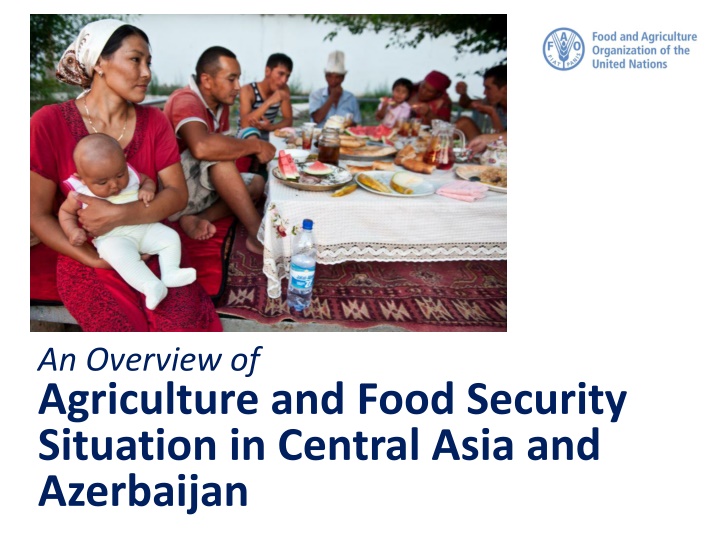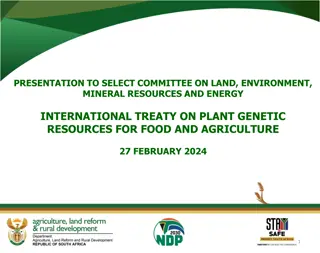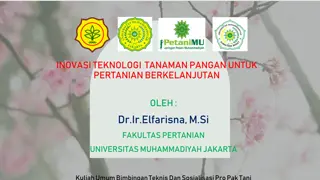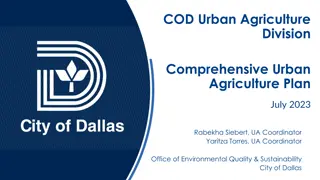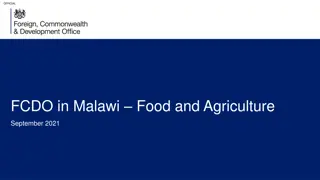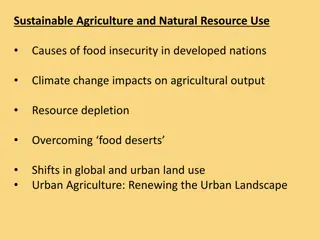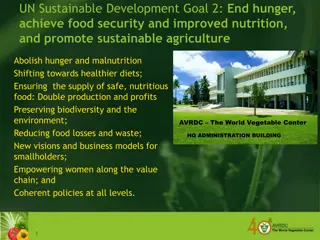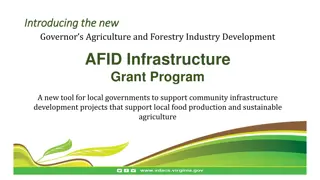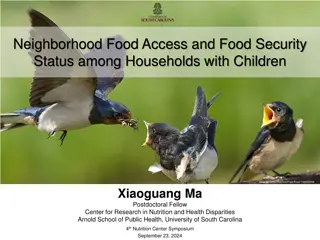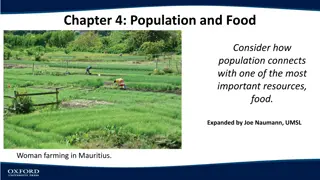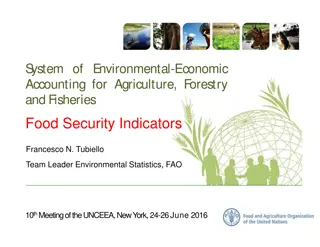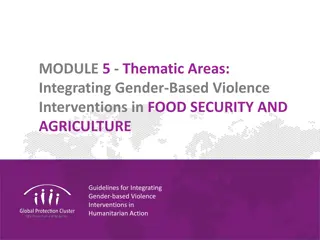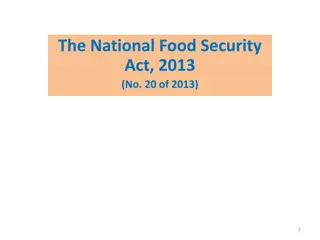Agriculture and Food Security
Providing an insightful analysis of the agriculture and food security situation in Central Asia and Azerbaijan, this content sheds light on key issues and challenges facing the region. It discusses various aspects such as agricultural practices, food production, and strategies for enhancing food security.
Download Presentation

Please find below an Image/Link to download the presentation.
The content on the website is provided AS IS for your information and personal use only. It may not be sold, licensed, or shared on other websites without obtaining consent from the author.If you encounter any issues during the download, it is possible that the publisher has removed the file from their server.
You are allowed to download the files provided on this website for personal or commercial use, subject to the condition that they are used lawfully. All files are the property of their respective owners.
The content on the website is provided AS IS for your information and personal use only. It may not be sold, licensed, or shared on other websites without obtaining consent from the author.
E N D
Presentation Transcript
An Overview of Agriculture and Food Security Situation in Central Asia and Azerbaijan
Socio-Economic background Demographics: Central Asian Region countries population (millions, WB, 2013): Uzbekistan (30.2), Kazakhstan (17), Tajikistan (8.1), Kyrgyzstan (5.7), Turkmenistan (5.2). Per capita GNIs (USD, WB, 2014): Uzbekistan (2,090), Kazakhstan (11,670), Tajikistan (1,080), Kyrgyzstan (1,250), Turkmenistan (8,020). Role of agriculture in economies and contribution to GDPs: between roughly 20-29% for Uzbekistan, Turkmenistan, Tajikistan and Kyrgyzstan, about 6% for Kazakhstan. About 60-70% of population in rural areas, depending on agriculture (subsistence and income).
Remittances from labour migration (Russia etc.) and contribute significantly to GDPs. In 2008, remittances amounted to: (15-25% of remittances invested in agriculture (livestock, crops, processing etc). Uzbekistan over 4 billion USD Tajikistan - over 2 billion Kyrgyzstan over 1 billion USD The national poverty incidence level at national poverty lines (%, WB, 2009): Uzbekistan Kazakhstan Tajikistan Kyrgyzstan Turkmenista n n/a 16 2.9 47.2 37%),
General trends of agricultural production and marketing In livestock sector smallholder producers (households) are responsible for over 90% of CA countries milk and meat production Landholdings owned by smallholders are fragmented and small, on average between 0.2-0.5 ha of arable land. It limits effective use of agricultural land and possible solution may be land consolidation. The Agricultural productivity dropped after the collapse of the Soviet Union, remains low for crop and livestock production. Lack of access to quality inputs: seed, fertilizer, veterinary drugs and medicine, chemicals etc.
Lack of reliable extension services. The extension services became almost extinct following the collapse of the Soviet Union. The share of processed products remain critically low (e.g. dairy estimated upto 5-10%, meat: 2-3% of the total output). There is room for value adding interventions to enable producers to capture the extra profits. Marketing of agricultural produce remains an issue for all CA countries due to several factors: (i) lack of infrastructure: storage facilities, roads, access to market information system etc; (ii) lack of food safety and quality standards (HACCP, ISO etc); (iii) lack of proper packaging, labeling and branding strategy; (iv) government regulations and policies hampering the imports and exports.
Endowments of CA countries Kyrgyzstan and Tajikistan have ample water resources used for irrigation and generating electricity (roughly 80% of water resources originate from two countries) CA countries enjoy vast bio-diversity resources, including pastures, and have untapped resources for development of fisheries, apiculture and other sub-sectors Availability of scientific and research institutions and a high potential for further development
Challenges faced by CA countries Adaption to climate change by promoting climate adaptation and mitigation practices (e.g. climate smart agriculture) Continuing de-forestation, land degradation and inefficient use of water resources
Opportunities - Potential areas for cooperation FAO has comparative advantage in technical areas and can share the vast knowledge and best practices across the CA countries FAO provides strategic planning, investment and coordination support through development of CPFs and sectoral policy and strategy documents (irrigation, NRM etc) FAO can provide comprehensive support on agriculture and rural development focusing on poverty, smallholders, gender, climate change, natural resources management, human rights based approach, knowledge management/sharing and other areas
The State of Food Insecurity in the World 2015 What is SOFI? Reviewing the progress made since 1990 in every country and region Making hunger, food insecurity, and malnutrition history Post-2015: How much progress made towards achieving hunger targets And reflects on what needs to be done Why this SOFI? Marks the end of the monitoring period for: #sofi2015 The World Food Summit goal, pledging to halve the number of undernourished people between 1990 and 2015 The Millennium Development Goal 1 hunger target, pledging to halve the proportion of undernourished people between 1990 and 2015 Progress Progress continues in the fight against hunger, yet an unacceptably large number of people still lack the food they need for an active and healthy life. 795 million undernourished people in the world in 2014 16 780 million in developing regions Decline by 216 million since 1990 92 and by 167 million over the last 10 years (faster progress) /faoturkiye www.fao.org/europe
State of Food Insecurity in the World 2015 #sofi2015 Most countries in the subregion achieved MDG targets. More progress needed in Tajikistan) /faoturkiye www.fao.org/europe
State of Food Insecurity in the World 2015 #sofi2015 Progress towards achievement of the MDGs and WFS hunger goal (%) 2015 /faoturkiye www.fao.org/europe
State of Food Insecurity in the World 2015 #sofi2015 Prevalence of undernourishment across the FAO SOFI regions and in Caucasus and Central Asia 2015 /faoturkiye www.fao.org/europe
State of Food Insecurity in the World 2015 #sofi2015 Child malnutrition indicators, 1991/ 2000/ 2010 /faoturkiye www.fao.org/europe
State of Food Insecurity in the World 2015 #sofi2015 Key Messages Progress on reducing the incidence of food insecurity is variable, some Central Asian countries still face challenges. 2015 budgetary issue in the region. Despite positive trends in food security, child malnutrition continues to be a problem in the region in both rich and poorer countries. This can be seen in relatively high rates of stunting in the Caucasus and Central Asian countries, and high levels of anemia in children under 5 in several countries. Overweight and obesity are an increasing nutrition, health and Countries across the region differ in their strategies for ensuring food security and agricultural development. /faoturkiye www.fao.org/europe
State of Food Insecurity in the World 2015 #sofi2015 Kazakhstan Uzbekistan 2015 Kyrgyzstan Azerbaijan Turkmenistan Turkey Tajikistan /faoturkiye www.fao.org/europe
State of Food Insecurity in the World 2015 #sofi2015 To download the report: http://www.fao.org/hunger/en/ Regional Overview: http://bit.ly/1FV79mQ /faoturkiye www.fao.org/europe
